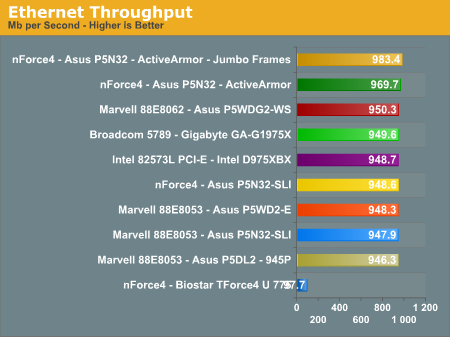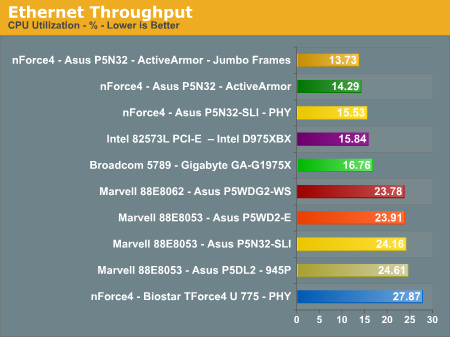NVIDIA nForce4 Ultra: Biostar's Performance Surprise
by Gary Key on February 16, 2006 12:05 AM EST- Posted in
- Motherboards
Ethernet Performance
The current motherboard test suite includes LAN performance measurements. All of these boards utilize PCI Express controllers with the only difference being the supplier of the core logic.
The Windows 2000 Driver Development Kit (DDK) includes a useful LAN testing utility called NTttcp. We used the NTttcp tool to test Ethernet throughput and the CPU utilization of the various Ethernet Controllers used on the Intel motherboards.
We set up one machine as the server; in this test, an Intel system with an Intel CSA Gigabit LAN connection. Intel CSA has a reputation for providing fast throughput and this seemed a reasonable choice to serve our Gigabit LAN clients.
At the server side, we used the following Command Line as suggested by the VIA whitepaper on LAN testing:
All standard Ethernet tests were performed with standard frames and the NVIDIA Active Armor suite disabled unless otherwise noted. Gigabit Ethernet supports Jumbo frames as well and provides a further reduction in CPU overhead. We added another test scenario in which ActiveArmor and Jumbo frames were enabled on the Asus P5N32-SLI Deluxe board via the 6.82 WHQL platform driver set. This is shown for illustrative purposes and shows the favorable impact of this technology.
The current motherboard test suite includes LAN performance measurements. All of these boards utilize PCI Express controllers with the only difference being the supplier of the core logic.
The Windows 2000 Driver Development Kit (DDK) includes a useful LAN testing utility called NTttcp. We used the NTttcp tool to test Ethernet throughput and the CPU utilization of the various Ethernet Controllers used on the Intel motherboards.
We set up one machine as the server; in this test, an Intel system with an Intel CSA Gigabit LAN connection. Intel CSA has a reputation for providing fast throughput and this seemed a reasonable choice to serve our Gigabit LAN clients.
At the server side, we used the following Command Line as suggested by the VIA whitepaper on LAN testing:
Ntttcpr -m 4 ,0,‹server IP› -a 4 -l 256000 -n 30000On the client side (the motherboard under test), we used the following Command Line:
Ntttcps -m 4 ,0,‹client IP› -a 4 -l 256000 -n 30000At the conclusion of the test, we captured the throughput and CPU utilization figures from the client screen.


All standard Ethernet tests were performed with standard frames and the NVIDIA Active Armor suite disabled unless otherwise noted. Gigabit Ethernet supports Jumbo frames as well and provides a further reduction in CPU overhead. We added another test scenario in which ActiveArmor and Jumbo frames were enabled on the Asus P5N32-SLI Deluxe board via the 6.82 WHQL platform driver set. This is shown for illustrative purposes and shows the favorable impact of this technology.










31 Comments
View All Comments
Calin - Friday, February 17, 2006 - link
What about sorting the graphs based on the min frame rate?:) I guess some people are never happy ;)
Great job, and a nice article!
yacoub - Thursday, February 16, 2006 - link
Once you've owned a passively-cooled motherboard like any of the recent Asus ones, it's hard to even look at one with a fan on it. It also makes shopping for a motherboard a LOT easier because you just cross off all the fan ones right away (unless you're a mod fiend who will actually go through the trouble of buying a chipset cooler or two and rip the fan assembly off the brand new expensive motherboard and hope that cools it well enough).I hope more manufacturers take up the passively-cooled trend.
Gary Key - Sunday, February 19, 2006 - link
I disabled the fan and only witnessed a 2c increase on the MCP. Biostar could have saved a few cents and put towards a Gigabit Lan solution. ;-)Marlin1975 - Thursday, February 16, 2006 - link
Sound and ethernet. Why do companies keep using the realtek junk. bad quality (part and drivers) and juts shows a motherboard company does not care when they use realtek.Any time I see realtek on a board I think the sound and even ethernet were a after thought like "Oh we forgot sound. Lets just put the cheapest POS on there. OK"
COME ON. Good chipset but you come so close then put junk on for sound and so forth.
Myrandex - Thursday, February 16, 2006 - link
For me that issue doesn't matter at all. My Sound Blaster Audigy 2 is still doing its job nicely, and getting a nice onboard sound solution still gets disabled all the same. Now for integrated SB Giga-bite ethernet is something that comes into play with my decisions, and I have been real happy with Giga-byte putting ieee1394b controllers on their boards (and am hoping that external HDD 1394B cases fall in price sooner or later). Integrated wireless is a neat feature some boards have as well.Wesley Fink - Thursday, February 16, 2006 - link
Realtek does have some really cheap audio and LAN chips, but they also have some pretty decent products. In the High Definition area the ALC882 is a really good audio codec with an excellent feature set that produces decent sound and very low noise. If you go through some recent reviews you will see both Gary and I have praised the Realtek ALC882, which is NOT included on this Biostar board :-)Marlin1975 - Thursday, February 16, 2006 - link
yea but you also go on about bad drivers that are STILL in need fo a update and other issues. So sorry but realtek is still junk in my book. That and with so many other options from VIA's envy, c-media, etc... why use something that has problems and are STILL being addressed today?DigitalFreak - Thursday, February 16, 2006 - link
I agree. Using Realtek for LAN is bad enough, but using a PCI solution? That's unacceptible. Even if you don't care about GbE, the CPU utilization is rediculous!Peter - Tuesday, February 21, 2006 - link
The RTL8201 is not a PCI ethernet chip, it's just a PHY companion to the chipset's own engine. This is a research error in the article.http://www.realtek.com.tw/products/products1-2.asp...">http://www.realtek.com.tw/products/products1-2.asp...
The abysmal performance rather more likely stems from transmission errors or poor signal quality - which would point to a damaged or poorly laid out board, or bad cabling.
PHYsical interface chips have zero influence on throughput, as long as signal integrity is being maintained - and as far as that is concerned, Realtek's solution is definitely up to the job. Question is, is the mainboard's layout?
Peter - Tuesday, February 21, 2006 - link
... and of course, we need to keep in mind it's a 10/100 PHY, not a gigabit PHY.